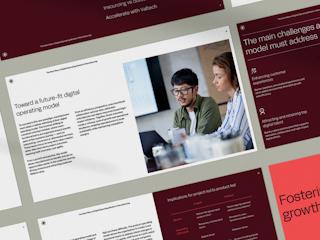This isn’t just a technology problem. It’s a funding problem. Traditional budgeting models, built around fixed timelines and rigid scopes, can’t keep up with today’s demands for agility, personalization and continuous delivery.
In an environment of shrinking budgets and increased scrutiny, manufacturers need smarter, more adaptive ways to fund digital work.
The shift: From projects to products
Many industrial and manufacturing companies still fund digital projects through highly structured business cases. These models are built for predictability, but that often comes at the cost of flexibility, exposing deeper issues:
- Budgets are tied to fixed milestones, not actual business outcomes.
- Business cases overpromise, leading to scope creep or stakeholder disappointment.
- Funding cycles move slowly while market and customer needs shift rapidly.
- Teams lack the autonomy to test, iterate and reprioritize based on real-time data.
- Costs continue to rise even as digital capabilities fall behind expectations.
In a volatile economic and regulatory environment, this is untenable. Leaders must justify larger capital outlays with less certainty of return. And as data systems, rebate programs and merchandising operations grow more complex, scaling transformation becomes even harder.
The solution? Move from static, project-based funding to a product-based, outcome-oriented model — one that enables agility, encourages accountability and prioritizes measurable value over rigid deliverables.
The case for product-based funding
A product-based funding model changes the game by tying investment to performance, not just activity.
Instead of funding isolated projects with narrow scopes, it allocates resources to teams solving ongoing business challenges. Funding becomes fluid, continuously reassessed and aligned to real-time goals.
This approach:
- Ties budgets to commercial and customer outcomes, not just project plans.
- Empowers cross-functional teams to prioritize based on impact.
- Enables iterative delivery, reducing risk and accelerating value.
- Supports continuous improvement in personalization, self-service and data quality.
A product-based model turns funding into a growth enabler, not a constraint.
Funding with purpose: Solving real problems
For B2B organizations, speed is only part of the challenge. Product-based funding also addresses deep, structural pain points:
- Poor data practices lead to wasted spend on disconnected systems and duplicate efforts.
- Lack of real-time insight causes missed cross-sell or upsell opportunities.
- Inefficient rebate and discount management leaves value on the table.
- Legacy systems drain resources and slow innovation.
- Underdeveloped self-service tools drive service costs higher.
A product-based model enables targeted funding around strategic goals — like improving product data, optimizing pricing or launching new customer experiences — then scaling once impact is proven.
What this looks like in practice
Rather than budgeting $1 million for a one-time “digital catalog redesign,” imagine funding a product team with the goal of improving product discoverability and revenue generation. That team could:
- Consolidate and enrich product data.
- Integrate real-time inventory and pricing.
- Roll out smarter search and filtering based on user behavior.
- Measure success via increased conversions, fewer support calls and faster reorders.
This outcome-driven model creates transparency for leadership and flexibility for teams.
Best practices for product-based funding
To make this model work, manufacturers need a shift in mindset, governance and capability planning. Here’s how to get started:
1. Align budgets with strategy
Connect funding to long-term goals like customer lifetime value, revenue growth or operational efficiency.
2. Foster transparency and agility
Regularly review funding against performance data. Stay open about what’s working and where to pivot.
3. Build cross-functional teams
Bring sales, marketing, IT and data together with shared accountability for success.
4. Invest in capability development
Fund not just delivery, but also the skills needed to drive value — like CX design, pricing strategy and data analytics.
5. Pilot and scale
Start small in high-impact areas. Expand the model as success metrics are met.
Technology’s role in enabling agile funding
Product-based funding works best when supported by a composable technology architecture. Modular systems allow for rapid integration, targeted upgrades and experimentation without massive replatforming. This flexibility helps track performance, accelerate enhancements and ensure long-term scalability.












